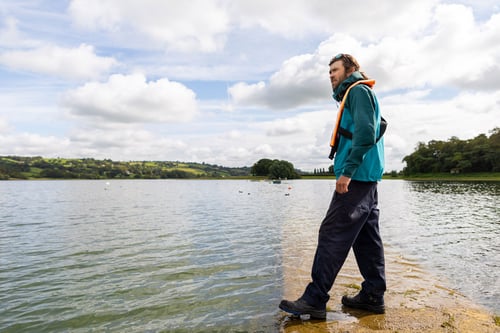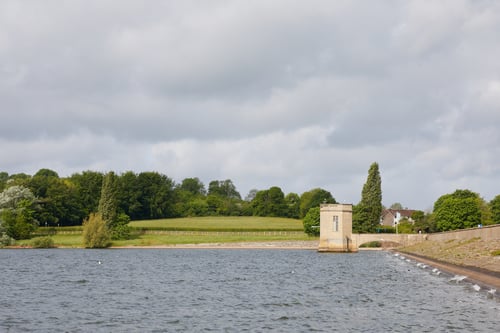Reservoir safety
Reservoirs are beautiful but they can also be very dangerous.

Please enjoy our reservoirs safely
Reservoirs are beautiful but they can also be very dangerous. Every year, we remind people why it’s not safe to swim in our reservoirs because of the risks that can affect even strong experienced swimmers.
The 2023 figures from the National Water Safety Forum show that inland waters, such as lakes and reservoirs, continue to be the leading locations for accidental drownings.
Stay safe, stay out - why you can't swim in reservoirs
Reservoirs are deep open bodies of water, that can be tempting for swimming, especially in hot weather. They can have unexpected changes in depth, especially near the edges. It is never safe to jump into the water.

Hidden dangers
Reservoirs are operational sites and are important in the water treatment process. There are concrete structures and hidden machinery working under the surface of the water, that can cause injury.
These underwater hazards include water intakes (suction pipes) that create strong, unpredictable currents affecting the ability to swim safely, or can pull swimmers under the water.
Plant life
Underwater plant life can also entangle swimmers and cause greater fatigue. The sides of the reservoirs are steep and often covered in mud or algae, making it easy to slip into the water, but much more difficult to climb out.
Blue green algae build up at the edges of reservoirs is called cyanobacteria and can also be very dangerous to humans and animals. Swimming or going into the reservoirs when this algae is present can make you very sick.
There isn’t a safe or effective way for us to remove the algae from the reservoir. But rest assured water from the reservoir goes through an extensive treatment process before it reaches your tap to make sure it’s clean and ready to drink.
No help at hand
Reservoirs are often remote, secluded areas and have no lifeguarding facilities. Poor mobile phone signal can hinder rescue attempts in the event of an emergency.
Buoys in the water may look tempting as flotation aids, but they are marking the site of aerators. Aerators keep the water ecologically balanced by pumping in air, but this also means the water is less dense, making it much harder than normal for swimmers to stay afloat.

Cold water shock
Deep water in reservoirs means temperatures rarely rise above 12 degrees, even on a warm summer’s day. This is defined as ‘cold water’ and can seriously affect your breathing and movement.
Cold water shock is a precursor to drowning. Temperatures are cold enough to stiffen muscles, inducing fatigue, making it impossible to stay afloat or swim to safety. The shock of cold water causes uncontrollable change in breathing rates, contributing to a feeling of panic and can lead to hyperventilation, depriving the brain of oxygen which affects coordination.
Cold water also causes heart rates to increase as blood pressure rises, making even the young and healthy vulnerable to heart attacks. More information on Cold Water Shock.
Contacting us
Every year we receive reports of swimming at our reservoirs. It is extremely dangerous to enter the water and we would urge anyone who sees this sort of activity, to contact our 24-hour helpline on 0345 702 3797.
If you see someone in trouble
If you do see someone who is in difficulty in the water, contact the emergency services (999 or 112 and ask for the coastguard).
Reassure them that help is coming.
Keep them in your line of sight and where possible, throw something buoyant to aid their safety until help arrives, without endangering yourself or getting too close to the slippery banks.
If you find yourself in the water
If you slip into a reservoir, take a minute before attempting to swim.
Try to relax. Your instinct will tell you to try to swim, but cold water shock can make you gasp for air uncontrollably and breathe in water.
Float to live. Tilt your head back with your ears submerged, try to breathe normally, move your hands to stay afloat and spread your arms and legs to improve stability.
Once your breathing is under control, call for help or swim to safety.
Water sports and sailing
Cheddar Water Sports Club and Chew Valley Lake Sailing Club do operate on the reservoirs, but this is properly risk assessed, everyone wears flotation devices and the clubs are made aware of activities on the water, meaning they are closely supervised. Safety boats are available and all appropriate safety measures are put in place.
All activities on the water are carefully managed by the community clubs, with safety policies and systems in place.
The clubs do not permit their members to swim, unless recovering a capsized craft. Swimming while there are boats on the water, especially rigid inflatable boats with propellors is dangerous and potentially fatal.
For your own safety, do not paddleboard, sail or partake in any water sport activities on our reservoirs, unless you’ve booked an activity with one of the authorised clubs.
One of the main reasons why we don’t allow people to launch their own craft on our reservoirs is that it might introduce invasive species, which could be costly to remove and damaging to the native wildlife.
If you see someone in trouble
If you do see someone who is in difficulty in the water, contact the emergency services (999 or 112 and ask for the coastguard).
Reassure them that help is coming.
Keep them in your line of sight and where possible, throw something buoyant to aid their safety until help arrives, without endangering yourself or getting too close to the slippery banks.
If you find yourself in the water
If you slip into a reservoir, take a minute before attempting to swim.
Try to relax. Your instinct will tell you to try to swim, but cold water shock can make you gasp for air uncontrollably and breathe in water.
Float to live. Tilt your head back with your ears submerged, try to breathe normally, move your hands to stay afloat and spread your arms and legs to improve stability.
Once your breathing is under control, call for help or swim to safety.
Water sports and sailing
Cheddar Water Sports Club and Chew Valley Lake Sailing Club do operate on the reservoirs, but this is properly risk assessed, everyone wears flotation devices and the clubs are made aware of activities on the water, meaning they are closely supervised. Safety boats are available and all appropriate safety measures are put in place.
All activities on the water are carefully managed by the community clubs, with safety policies and systems in place.
The clubs do not permit their members to swim, unless recovering a capsized craft. Swimming while there are boats on the water, especially rigid inflatable boats with propellors is dangerous and potentially fatal.
For your own safety, do not paddleboard, sail or partake in any water sport activities on our reservoirs, unless you’ve booked an activity with one of the authorised clubs.
One of the main reasons why we don’t allow people to launch their own craft on our reservoirs is that it might introduce invasive species, which could be costly to remove and damaging to the native wildlife.
If you see someone in trouble
If you do see someone who is in difficulty in the water, contact the emergency services (999 or 112 and ask for the coastguard).
Reassure them that help is coming.
Keep them in your line of sight and where possible, throw something buoyant to aid their safety until help arrives, without endangering yourself or getting too close to the slippery banks.
If you find yourself in the water
If you slip into a reservoir, take a minute before attempting to swim.
Try to relax. Your instinct will tell you to try to swim, but cold water shock can make you gasp for air uncontrollably and breathe in water.
Float to live. Tilt your head back with your ears submerged, try to breathe normally, move your hands to stay afloat and spread your arms and legs to improve stability.
Once your breathing is under control, call for help or swim to safety.
Water sports and sailing
Cheddar Water Sports Club and Chew Valley Lake Sailing Club do operate on the reservoirs, but this is properly risk assessed, everyone wears flotation devices and the clubs are made aware of activities on the water, meaning they are closely supervised. Safety boats are available and all appropriate safety measures are put in place.
All activities on the water are carefully managed by the community clubs, with safety policies and systems in place.
The clubs do not permit their members to swim, unless recovering a capsized craft. Swimming while there are boats on the water, especially rigid inflatable boats with propellors is dangerous and potentially fatal.
For your own safety, do not paddleboard, sail or partake in any water sport activities on our reservoirs, unless you’ve booked an activity with one of the authorised clubs.
One of the main reasons why we don’t allow people to launch their own craft on our reservoirs is that it might introduce invasive species, which could be costly to remove and damaging to the native wildlife.